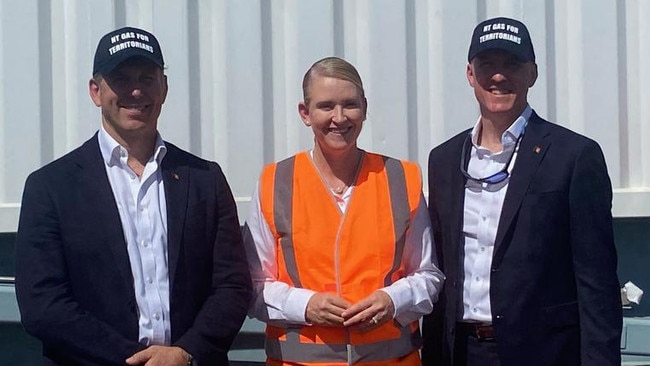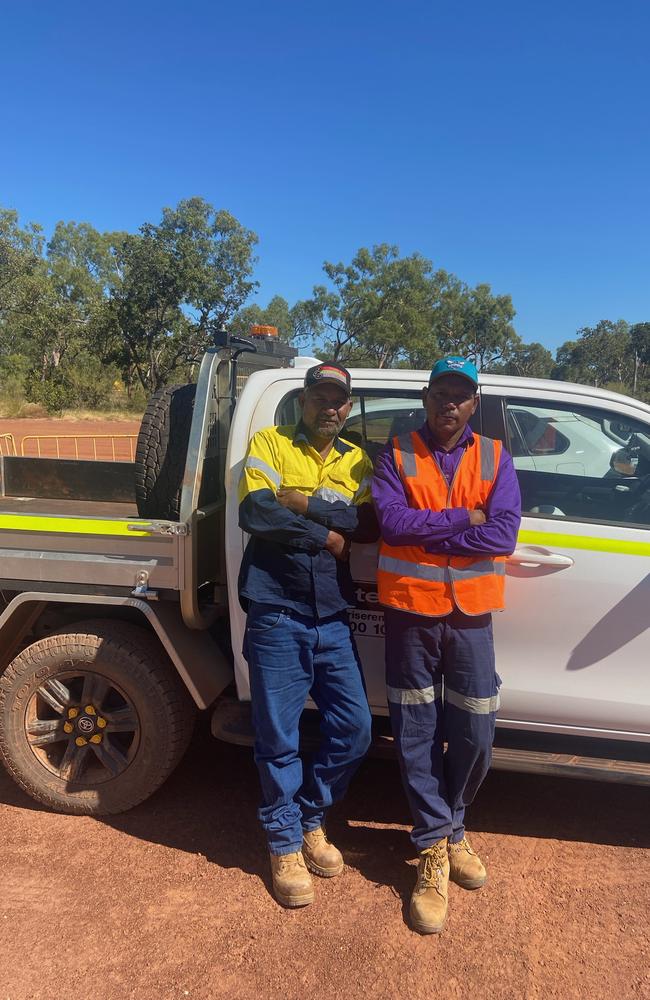Aboriginal leaders defend onshore gas as Tamboran fracking project pushes for production
Community leaders in regional Territory centres can’t wait for onshore gas production to begin and have clear message for opponents. Read what they say.
Business
Don't miss out on the headlines from Business. Followed categories will be added to My News.
The government green light for the shale gas industry in early May has seen an activity surge at the largest of the Territory’s two onshore gas projects.
Tamboran Resources wasted no time starting work.
Within two days of the government announcing work at the Beetaloo could begin, chief executive Joel Riddle held a media event at Darwin Port to show off a newly arrived drilling rig.
He declared it was “go time in the Beetaloo” – with activity at Tamboran’s six Beetaloo Basin sites increasing in recent weeks to reflect an ambitious production deadline targeting final quarter 2024.
When this masthead toured Tamboran’s Kyalla site this month, bits of rig were lying in the dust as a small number of workers continued preparation for more deliveries in coming weeks.

A team of American rig operators had just been collected from Daly Waters airstrip to operate the new drill and demountables were ready for the workforce surge when drilling begins.
Dozens of roadtrains have been hauling Helmerich and Payne’s Flex 3 rig up the highway since May.
If drilling is successful and production levels sustainable, Tamboran could deploy another four similar rigs to the Beetaloo.
Described as the largest and fastest onshore gas drilling rig – the Flex 3 rig can drill in 10 days what could otherwise take 70 – Tamboran expects it will be in place by the end of August.

The first well at Kyalla’s EP98 permit was plugged last year and the Flex 3 will drill the second at the permit site.
Usually up to 20 workers are at Kyalla but the worksite swells to about 70 employers when drilling begins.
This is nothing compared to the thousands expected to work on the Beetaloo if production goes ahead at either Tamboran’s or Empire Energy’s reserves.
Traditional Owners Jeremy Jackson and Ben Ulamari have both been involved with Beetaloo for years and are thrilled at the prospect of jobs and regional development around Elliott. Jeremy’s brother Gordon Jackson, owner of PPP contracting, contacted Origin Energy looking for jobs in Elliott, and Ben through “humbugging” the company for work.
Five main TO groups are impacted by Beetaloo. Warranangku group for Beetaloo Station, Bamarrnganja group for Shenandoah-Hayfield stations, Pinda group for Vilkerri and Kinniningu group for Hayfield West. These make up the Jingili and Mudburra tribes.

“It could mean thousands of jobs if the Beetaloo project gets to go and will be unbelievable for employment in Elliot and around here,” Ben said.
“If it doesn’t go ahead it will just mean Elliott’s back on the waiting list for the next major project that turns up.”
Jeremy is employed by Tamboran and Ben formed Konan Contracting, his own headworks and civil business, that now sub-contracts with Tamboran at the Beetaloo.
Their view on the impact of fracking on their land is at odds with protesters who have driven the 30km unsealed road off the highway onto Hayfield Station where the approximately 6ha Kyalla site sits among the pastoral lease.
A few weeks ago there was a handful of vehicles parked outside the gate, their occupants exchanging side glances with Jeremy from inside their fossil-fuelled cars.
But security vision at the main gate and employment of security services on site give rise to genuine concerns that protesters might one day not be content to stay outside the gate in parked cars.

Emissions are key to concerns greens have about fracking as well as the capacity for damage to the huge Georgina Basin aquifer.
On the first, commonwealth government policy has gas as a transitional energy away from coal towards a full electric and battery conversion and the second, Indigenous custodians are 100 per cent convinced their water and land are safe.
Part of that is the four layers of casing around waterpipes that pass kilometres below the water table, independent off-site water testing and a raft of studies including the Pepper Inquiry and the Georgina Wiso Water Allocation Plan that point to the capacity to share the resource.
“It’s like taking a teaspoon out of a bucket of water. That’s it.” Ben said.
Jeremy said much of the early consultations with TOs was done by explorers Sweetpea, Falcon Energy and Origin Energy and they “consulted from day one”.
“We asked a lot of questions, we had meeting after meeting then some of these people on our side got information from people down south saying fracking’s bad and going to damage your country,” he said.
“But we consulted with the oil and gas companies and Northern Land Council was supporting the TOs’ decision.

“The NLC got the right TOs to speak because we speak on behalf of our own country, not other people’s country.
“They’re saying women will have babies born with two heads, that type of stuff. They make it up.”
Instead of entering the argument, Tamboran has quietly embarked on regional development projects including a plan to purify Elliott’s water supply, oval upgrades and kitting out the new Elliott Hawks AFL women’s team as well as the mens’.
Beetaloo field manager Robert Wear has been with the project since the first days of exploration in 2014, beginning with Origin, now with Tamboran and proud to be working on a nation-building project that wants to deliver gas to Darwin, Australia’s east coast and eventually LNG to South-East Asia processed at Middle Arm sustainable precinct.
“Basically, we do what we say,” he said.
“There are rules and regulations that need to be followed and we have to abide by those. We’re the biggest lease in the country and we have the 100 per cent support of TOs.”





